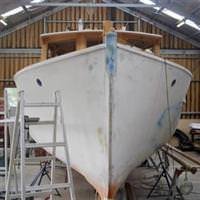The vessels, fashioned with a combination of traditional wooden boat-building skills and a modern shipyard at one of only a handful of wooden boat-building schools in the world, are custom-built to buyer specifications.

In some cases, this means expensive carpets and, in the case of the latest boat, state of the art kitchen appliances.
“There is one school in the United States but this one here in Tassie is the major one, and I think it’s the only one in the Southern Hemisphere that produces a large scale vessel as a major project,” said John Allport, manager of The Wooden Boat Center Boatbuilding School.
Eager apprentices travel from around the world to learn the art of wooden boat building using traditional hand tools and contemporary power tools to produce a vessel in an economically viable time frame, usually about 12 months.
A rich smell of pine hangs in the misty southern air in the boat shed at Franklin, 48 km (30 miles) southwest of Hobart, the capital of Australia’s island state Tasmania.
A shipwright wearing a bib and braces sits on a upturned milk crate at the bow of the boat he’s working on, marking the Plimsoll line with his pencil. His student, using a clear garden hose filled with water as a spirit level, calls out the levels to be marked as a sleepy dog keeps an eye on the activity.
A lot of teaching is with traditional type hand tools and traditional methods of boat building, but in the modern environment it’s just too slow,” said Allport, a bearded 56-year-old who has been at the school for six years as a manager.
“It’s fine to be taught traditional methods but if the students have to go out into the modern workplace they can find they are lacking in some skills so we are using traditional hand tools in a contemporary manner.”
LONG HISTORY, SUSTAINABILITY
Tasmania’s tradition of boat building began within days of its settlement in 1803 as a penal colony, densely populated with ideal boat-building timbers in an era when wooden schooners plied the surrounding waters.
Vessels built by the convicts could withstand the notoriously rough Bass Strait, the stretch of water which runs between the southern tip of Australia’s mainland and Tasmania.
The Wooden Boat Center, which advocates sustainability, uses Huon, King Billy, Celery Top, Blue Gum and Swamp Pines — the same prized varieties used then. The current timber comes from a “Wood Bank” established by the Tasmanian government over 20 years ago dedicated to boat building and fine furniture.
They’re traditionally built vessels, mainly using Tasmanian timbers, in particular Huon Pine. It’s got a natural oil in it that stops decay and worm attack. It will last for hundreds of years,” said Allport.
While the atmosphere at the boatyard is calmly industrious, juggling the demands of finding sponsors and students, the size of the boat, and the all-important fees is a constant struggle.
In addition, while buyers seek out the school for its traditional boat building, they also require fitting out with state of the art equipment — and catering to many whims.
In one case, a buyer wanted to lay expensive carpet, covering the beautiful timber floor. When the surprised boat builders asked why, the buyer’s wife said she liked the color.
Buyers tend to be business people, with Australians dominating. International interest has often been expressed, but distance and the cost of shipping from Australia can prove a deterrent in many cases.
Currently under construction is a carvel planked, which means planks laid side by side, 38-foot motor cruiser for Tetsuya Wakuda, a renowned Australian chef whose wants included a seven-foot table and an induction stove in the galley.
“I wanted a boat built that looked traditional on the outside and modern on the inside. I’ve always loved boats,” Wakuda said.
“I have every kitchen appliance you can imagine on the boat… I have made the best of the galley. I wanted a boat like they’d never built before, the best of the best.”
Needless to say, such luxury does not come cheaply, though prices vary according to the buyer’s desire. Wakuda’s boat carries an A$700,000 ($749,000) price tag.
Completion of any boat becomes a community celebration, with the entire town of Franklin coming out for the launching of each boat as they slide into the Huon River.
Wakuda’s boat, the largest the boatyard has made so far, is set for launching on June 1, Allgood said.
“It’s going to be a squeeze to get out the door,” he added.